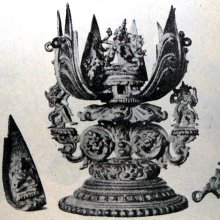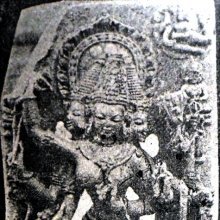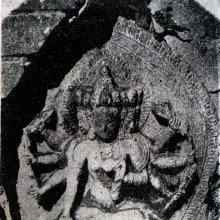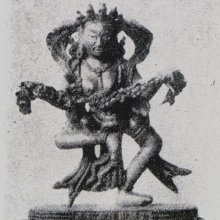Shumbha, Sumbha, Śumbha: 19 definitions
Introduction:
Shumbha means something in Buddhism, Pali, Hinduism, Sanskrit, Marathi, Jainism, Prakrit. If you want to know the exact meaning, history, etymology or English translation of this term then check out the descriptions on this page. Add your comment or reference to a book if you want to contribute to this summary article.
The Sanskrit term Śumbha can be transliterated into English as Sumbha or Shumbha, using the IAST transliteration scheme (?).
Images (photo gallery)
In Hinduism
Purana and Itihasa (epic history)
Source: archive.org: Puranic Encyclopedia1) Śumbha (शुम्भ).—An asura. (See under Niśumbha).
2) Sumbha (सुम्भ).—An asura; the eldest of the three sons, more powerful than Indra, born to Kāśyapaprajāpati by his wife Danu, the other two sons being Niśumbha and Namuci. (For details see under Niśumbha).
Source: archive.org: Shiva Purana - English TranslationŚumbha (शुम्भ) is the name of an Asura, according to the Śivapurāṇa 2.5.20 (“The fight between the Gaṇas and the Asuras”).—Accordingly, as Jalandhara commanded: “Let all the Asuras such as Kālanemi and others set out with their entire divisions; Śumbha, Niśumbha and other heroes; the descendants of Koṭivīra, the scions of the family of Kambu. Daurhṛdas, Kalakas, Kālakeyas, Mauryas and Dhaumras—let all these start for the fight. After ordering thus, the lord of the Asuras the valorous son of the ocean set out quickly accompanied by crores of Daityas. [...]”.
Source: Cologne Digital Sanskrit Dictionaries: The Purana Index1a) Śumbha (शुम्भ).—A commander of Tāraka's force; had the sheep for his riding animal;1 threw darts on Janārdana; a Citrayodhi against Janārdana who threw bhusuṇḍi at him and his goat and said “you are to be killed by a girl; get away;”2 killed by Durgā;3 killed by Yoganidrā.4
- 1) Matsya-purāṇa 148, 43, 55; 151. 5.
- 2) Ib. 150. 224; 152. 25-52; 245. 32.
- 3) Brahmāṇḍa-purāṇa IV. 29. 76.
- 4) Viṣṇu-purāṇa V. 1. 82.
1b) A son of Ganeṣṭhi.*
- * Vāyu-purāṇa 67. 77.

The Purana (पुराण, purāṇas) refers to Sanskrit literature preserving ancient India’s vast cultural history, including historical legends, religious ceremonies, various arts and sciences. The eighteen mahapuranas total over 400,000 shlokas (metrical couplets) and date to at least several centuries BCE.
In Buddhism
Theravada (major branch of Buddhism)
Source: Pali Kanon: Pali Proper Names1. Sumbha. A Pacceka Buddha. M.iii.70; ApA.i.106.
2. Sumbha. A country in which was Desaka (?), where Udayi visited the Buddha during a stay there, and had a conversation with him. S.v.89; cf. 168, and J.i.393; also SA.iii.181.
Theravāda is a major branch of Buddhism having the the Pali canon (tipitaka) as their canonical literature, which includes the vinaya-pitaka (monastic rules), the sutta-pitaka (Buddhist sermons) and the abhidhamma-pitaka (philosophy and psychology).
Tibetan Buddhism (Vajrayana or tantric Buddhism)
Source: Wisdom Library: Tibetan BuddhismSumbha (सुम्भ) refers to one of the male Vidyā-beings mentioned as attending the teachings in the 6th century Mañjuśrīmūlakalpa: one of the largest Kriyā Tantras devoted to Mañjuśrī (the Bodhisattva of wisdom) representing an encyclopedia of knowledge primarily concerned with ritualistic elements in Buddhism. The teachings in this text originate from Mañjuśrī and were taught to and by Buddha Śākyamuni in the presence of a large audience (including Sumbha).
Source: archive.org: The Indian Buddhist Iconography1) Sumbhā (सुम्भा) refers to one of the ten Goddesses of the Vajratārāmaṇḍala belonging to Vajratārā: one of the various emanations of Ratnasambhava, as mentioned in the 5th-century Sādhanamālā (a collection of sādhana texts that contain detailed instructions for rituals).—Accordingly, the sādhana further says that the Guardians of the Gates should also be meditated upon as around the principal Goddess, but apparently not in the same circle with the [four cardinal Goddess]:—“Goddess Sumbhā occupies the lower regions”.
All these Goddesses [viz., Sumbhā] stand on the orb of the sun in the ālīḍha attitude with the right leg stretched forward. They are radiant like the Sun-god and are surrounded with a fiery halo. They are decked in ornaments of snakes. [...] These Goddesses originate from the ten different letters of the mantra of Vajratārā, which is “oṃ tāre tuttāre ture svāhā”, consisting of ten syllables. Each syllable brings forth a Goddess, and these Goddesses are said to be the embodiments of the ten paramitas of the Mahāyāna School.
2) Sumbhā (सुम्भा) presides over the Nether region and represents one of the six Goddesses of the directions, commonly depicted in Buddhist Iconography, and mentioned in the 11th-century Niṣpannayogāvalī of Mahāpaṇḍita Abhayākara.—Her Colour is blue; her Symbol is the noose of snake; she has one face and two arms.—The sixth and the last goddess in the series is Sumbhā who is the presiding deity of the Nether region.
Sumbhā is described in Niṣpannayogāvalī (vajratārāmaṇḍala) and Sādhanamālā (vajratārāsādhana) as follows:—
Source: MDPI Books: The Ocean of Heroes“Below is Sumbhā blue in colour, holding in her left hand the Nocse made of a snake”.
[Her left hand as usual displays the raised index finger.]
Sumbha (सुम्भ) refers to the Mantra used for subjugating obstacle-demons, according to the 10th-century Ḍākārṇava-tantra: one of the last Tibetan Tantric scriptures belonging to the Buddhist Saṃvara tradition consisting of 51 chapters.—Accordingly: [while explaining the body circle (kāyacakra)]: “[...] Killing (or [the mantra starting with] ‘sumbha’) is commanded. A vajra-holder, a vow-observer, performs piling—Oṃ, kill, knock down the body [obstacle], hūm hūṃ phaṭ. Oṃ, seize, seize the speech [obstacle], hūṃ hūṃ phaṭ. Oṃ, capture, capture the mind [obstacle], hūṃ hūṃ phaṭ. Oṃ, may [you who are] the Blessed One bring the gnosis one to [this place], hoḥ, O the adamantine one, hūṃ hūṃ phat. [...]”.

Tibetan Buddhism includes schools such as Nyingma, Kadampa, Kagyu and Gelug. Their primary canon of literature is divided in two broad categories: The Kangyur, which consists of Buddha’s words, and the Tengyur, which includes commentaries from various sources. Esotericism and tantra techniques (vajrayāna) are collected indepently.
Languages of India and abroad
Marathi-English dictionary
Source: DDSA: The Molesworth Marathi and English Dictionaryśumbha (शुंभ).—m (S The name of an Asura or demon slain by Durga.) Applied, appellatively, to a dull, sluggish, and stupid fellow.
--- OR ---
sumbha (सुंभ).—m ( H) A miser or niggard. 2 (Vulgar for śumbha) The name of an asura or demon. Hence, appellatively, a sluggish and stupid fellow.
Source: DDSA: The Aryabhusan school dictionary, Marathi-Englishśumbha (शुंभ).—m A dull, sluggish, stupid fellow.
--- OR ---
sumbha (सुंभ).—m A miser or niggard. A sluggish, stupid fellow.
Marathi is an Indo-European language having over 70 million native speakers people in (predominantly) Maharashtra India. Marathi, like many other Indo-Aryan languages, evolved from early forms of Prakrit, which itself is a subset of Sanskrit, one of the most ancient languages of the world.
Sanskrit dictionary
Source: DDSA: The practical Sanskrit-English dictionaryŚumbha (शुम्भ).—Name of a demon killed by Durgā.
Derivable forms: śumbhaḥ (शुम्भः).
Source: Cologne Digital Sanskrit Dictionaries: Edgerton Buddhist Hybrid Sanskrit DictionarySumbhā (सुम्भा).—name of a goddess (compare prec. but two): Sādhanamālā 180.7 etc.
Source: Cologne Digital Sanskrit Dictionaries: Shabda-Sagara Sanskrit-English DictionaryŚumbha (शुम्भ).—m.
(-mbhaḥ) An Asura or demon slain by Durga.
--- OR ---
Sumbha (सुम्भ).—m.
(-mbhaḥ) A country so named; also read suhya .
Source: Cologne Digital Sanskrit Dictionaries: Cappeller Sanskrit-English DictionaryŚumbha (शुम्भ).—[masculine] [Name] of an Asura.
--- OR ---
Sumbha (सुम्भ).—[masculine] [plural] [Name] of a people.
Source: Cologne Digital Sanskrit Dictionaries: Monier-Williams Sanskrit-English Dictionary1) Śumbha (शुम्भ):—[from śumbh] m. Name of an Asura or demon (slain by Durgā; he was the son of Gaveṣṭhin and grandson of Prahlāda), [Harivaṃśa; Rāmāyaṇa; Purāṇa]
2) Sumbha (सुम्भ):—m. [plural] Name of a people, [Rāmāyaṇa]
3) sg. Name of a country (cf. śumbha-deśa), [cf. Lexicographers, esp. such as amarasiṃha, halāyudha, hemacandra, etc.]
Source: Cologne Digital Sanskrit Dictionaries: Yates Sanskrit-English Dictionary1) Śumbha (शुम्भ):—(śa) śumbhati 6. a. To shine, be handsome; hurt; speak.
2) (mbhaḥ) 1. m. Demon slain by Durgā.
3) Ṣumbha (षुम्भ):—sumbhati 1. 6. a. Idem; be beautiful.
4) Sumbha (सुम्भ):—(mbhaḥ) 1. m. Name of a country.
Source: DDSA: Paia-sadda-mahannavo; a comprehensive Prakrit Hindi dictionary (S)Śumbha (शुम्भ) in the Sanskrit language is related to the Prakrit words: Suṃbha, Suṃbhā.
[Sanskrit to German]
Sanskrit, also spelled संस्कृतम् (saṃskṛtam), is an ancient language of India commonly seen as the grandmother of the Indo-European language family (even English!). Closely allied with Prakrit and Pali, Sanskrit is more exhaustive in both grammar and terms and has the most extensive collection of literature in the world, greatly surpassing its sister-languages Greek and Latin.
Prakrit-English dictionary
Source: DDSA: Paia-sadda-mahannavo; a comprehensive Prakrit Hindi dictionary1) Suṃbha (सुंभ) in the Prakrit language is related to the Sanskrit word: Śumbha.
2) Suṃbhā (सुंभा) also relates to the Sanskrit word: Śumbhā.
Prakrit is an ancient language closely associated with both Pali and Sanskrit. Jain literature is often composed in this language or sub-dialects, such as the Agamas and their commentaries which are written in Ardhamagadhi and Maharashtri Prakrit. The earliest extant texts can be dated to as early as the 4th century BCE although core portions might be older.
Kannada-English dictionary
Source: Alar: Kannada-English corpusŚuṃbha (ಶುಂಭ):—
1) [noun] a man disinclined to work or physical exertion; a lazy, indolent man.
2) [noun] a stupid fellow; a blockhead.
Kannada is a Dravidian language (as opposed to the Indo-European language family) mainly spoken in the southwestern region of India.
See also (Relevant definitions)
Starts with: Shumbhadesha, Shumbhaghatini, Shumbhahanani, Shumbhaka, Shumbhamana, Shumbhamarddini, Shumbhamardini, Shumbhamathani, Shumbhana, Shumbhanishumbha, Shumbhapura, Shumbhapuri, Shumbhasura, Shumbhavadha.
Query error!
Full-text (+121): Nishumbha, Shumbhaghatini, Shumbhapura, Shumbhanishumbha, Shumbhamarddini, Shumbhadesha, Shumbhamardini, Shumbhavadha, Shumbhahanani, Shumbhamathani, Shumbhapuri, Dhumralocana, Gundem, Shumbhasura, Sumbhatara, Nishumbhamathani, Nishumbhamardini, Sumba, Sambharaja, Cumpan.
Relevant text
Search found 48 books and stories containing Shumbha, Sumbha, Śumbha, Sumbhā, Ṣumbha, Suṃbha, Suṃbhā, Śumbhā, Śuṃbha; (plurals include: Shumbhas, Sumbhas, Śumbhas, Sumbhās, Ṣumbhas, Suṃbhas, Suṃbhās, Śumbhās, Śuṃbhas). You can also click to the full overview containing English textual excerpts. Below are direct links for the most relevant articles:
Markandeya Purana (Study) (by Chandamita Bhattacharya)
5. Origin of Caṇḍikā Śakti < [Chapter 3]
3. Birth of Ambikā / Kauśikī out of Pārvati’s body < [Chapter 3]
Śaktism (worship of Śakti as the female goddess) < [Chapter 4]
Chaitanya Bhagavata (by Bhumipati Dāsa)
Verse 3.2.276 < [Chapter 2 - Description of the Lord’s Travel Through Bhuvaneśvara and Other Placesto Jagannātha Purī]
Verse 2.10.100 < [Chapter 10 - Conclusion of the Lord’s Mahā-prakāśa Pastimes]
Padma Purana (by N.A. Deshpande)
Chapter 16 - Jālandhara Gives up His Disguise < [Section 6 - Uttara-Khaṇḍa (Concluding Section)]
Chapter 18 - Jālandhara Is Killed < [Section 6 - Uttara-Khaṇḍa (Concluding Section)]
Chapter 101 - The Fight Goes On < [Section 6 - Uttara-Khaṇḍa (Concluding Section)]
The Indian Buddhist Iconography (by Benoytosh Bhattachacharyya)
Figure 249 - Dacca image of Khadiravaṇī Tārā
Figure 180-183 - Emanations of Ratnasambhava: Vajratārā and Puṣpatārā
Skanda Purana (by G. V. Tagare)
Chapter 19 - The Fail of Vīrabhadra < [Section 4 - Kārttikamāsa-māhātmya]
Chapter 24 - Greatness of Kātyāyanī < [Section 3 - Arbuda-khaṇḍa]
Chapter 20 - Viṣṇu Fights with Daityas < [Section 2 - Kaumārikā-khaṇḍa]
Puranic encyclopaedia (by Vettam Mani)





